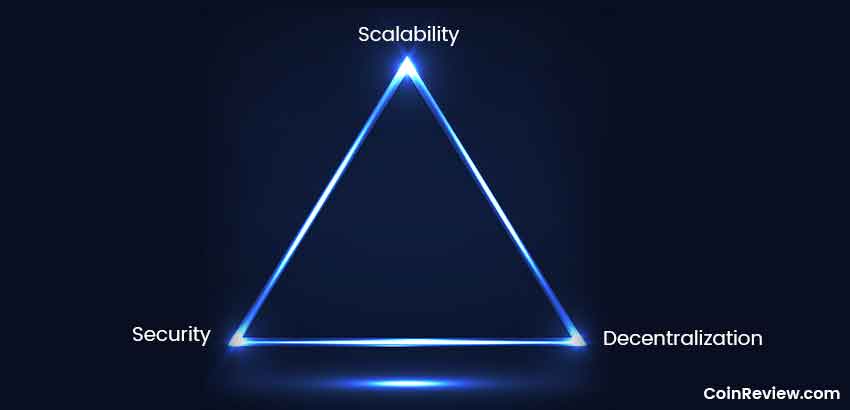Content Table
- Blockchain Trilemma and Consensus Mechanisms in Web3
- What is a Block in a blockchain?
- Challenges of Blockchain
- Blockchain Trilemma
- Desirable Attributes of a Consensus Mechanism
- Types of Consensus Mechanisms
- Conclusion
Blockchain technology has revolutionized the way we think about data storage and transaction validation. In today’s interconnected world, where information flows freely and trust is paramount blockchain stands as a decentralized, distributed, and immutable ledger where encrypted blocks of digital asset data are linked together (hence “block–chain”) through cryptographic hashes. In simpler terms, blockchain functions as a database established and maintained by a network of peer-to-peer nodes.

In this interconnected world, blockchain accuracy and longevity are dependent on certain protocols. Consensus mechanisms are protocols or sets of rules utilized among network participants (nodes) to unanimously agree on the validity and sequence of transactions. Their purpose is to ensure accuracy and security in a decentralized manner. The significance of consensus mechanisms lies in their role in upholding data integrity and preventing malicious actors from accessing distributed ledgers. Moreover, they establish the structure of decentralization.
Given that Web3 centres around decentralization and empowering individuals and the unbanked, both blockchain and consensus mechanisms remain integral. Think of a consensus mechanism as an organizational vote; a minimum of 51% of nodes must concur on what constitutes validity. The involvement of a consensus mechanism in blockchain is crucial, as it ensures that a majority of nodes or miners validate a transaction before it becomes part of the blockchain. These globally distributed peer-to-peer networks independently verify each transaction. The choice of consensus mechanism often varies between different blockchains, based on their objectives and specifications.
What is a Block in a blockchain?
Blocks serve as repositories for transaction data in a blockchain. These blocks are linearly connected and cryptographically secured. A block consists of two primary components: transactions and a block header. Block headers encompass the present hash address, previous hash, timestamp, nonce and other details. The previous hash address assists in locating the preceding block, while nonce is a unique number used to differentiate block hash addresses, usable only once. Transaction data which include the sender’s digital signature, asset details, price, and more.
Challenges of Blockchain
Beyond Web3’s interoperability concerns, the blockchain encounters the blockchain trilemma. Coined by Ethereum’s founder Vitalik Buterin, this concept stipulates that blockchain must compromise between security, decentralization, and scalability. Essentially, blockchain technology must make a trade-off involving these fundamental traits. For instance, Bitcoin boasts security and decentralization but only processes seven transactions per second. Ripple, on the other hand, offers security and scalability but is centralized.
Blockchain Trilemma
- Decentralization: Decentralization implies transferring authority and decision-making from centralized entities like banks to a distributed network. Consensus mechanisms bolster decentralization as they enable peers to independently agree on a universal truth without relying on central authority.
- Scalability: Scalability gauges a blockchain’s capacity to handle high transaction throughput and future transactions. Throughput refers to transactions processed per second by a blockchain network. However, the throughput of blockchain traffic decreases as the number of nodes increases, potentially leading to poor user experiences.
- Security: While scalability may require fewer nodes for higher throughput, reducing nodal distribution can compromise security. Sufficient nodes are crucial for safeguarding a blockchain’s security and integrity. An example of a security concern is the possibility of a 51% attack.
Desirable Attributes of a Consensus Mechanism
- A robust consensus mechanism should uphold decentralization, preventing a single entity from controlling the network.
- It must resist attacks such as double spending and 51% attacks.
- The mechanism should handle a high number of transactions while maintaining performance.
- Consensus mechanisms must enable accessibility for all participants regardless of their resources.
Types of Consensus Mechanisms
Developing a decentralized network governance that balances blockchain’s trilemma is a persistent challenge. Consequently, various networks have introduced consensus mechanisms that align with their priorities. The most popular mechanisms are proof of work (PoW) and proof of stake (PoS).
Proof of Work (PoW)
Bitcoin, Dogecoin, and Litecoin employ this protocol. Regarded as secure and resistant to “51% attacks”, PoW is more of a cryptographic puzzle-solving competition among network participants. The miners use computational power to solve mathematical puzzles and confirm the latest block’s transactions. Once a miner solves the puzzle, they broadcast their solution to the network and other nodes validate the accuracy before adding the block to the blockchain. The first miner to solve the puzzle gets to add a new block of transactions to the blockchain and is rewarded with newly minted cryptocurrency.
Proof of Stake (PoS)
PoS, the second most common mechanism, is adopted by blockchains like Polkadot, Avalanche, and Cardano. Instead of miners, validators are used to confirm data. To be eligible as a validator on the blockchain using POS, the validator is expected to stake the required amount of the blockchain’s native tokens. The staked token served as a form of collateral which they lose if they acted maliciously or incompetently. However, PoS carries a 51% attack risk if there are fewer nodes and attackers are in control over the majority of the staked resources they could gain control over the network. The POS mechanism has grown to have various variants each with its solution to achieve effective, resource-efficient network governance.
Delegated Proof of Stake (DPoS)
Just as the name implies, DPOS involve delegating validators based on the votes of stakeholders. The stakeholder passes their funds onto a third-party validator who in turn uses the fund to increase the chances of verifying or creating a new block. The DPOS improves the POS mechanism as stakeholders vote for the validator they trust. This can be interpreted as citizens electing a representative to make decisions on their behalf. In DPOS, token holders can vote out delegators who are underperforming and replace them with more trustworthy delegates. The voting in and out process enhances accountability within the network.
Leased Proof of Stake (LPoS)
This consensus mechanism is utilized by certain blockchain networks like Waves. Here, token holders lease funds to nodes for block verification. No voting occurs; LPOS gives regular token owners with lesser holdings the opportunity to contribute to the consensus mechanism. The regular token owners can also withdraw their lease from the validator when desired. The validators earn rewards for their work, and token holders who lease their tokens also receive a share of those rewards.
Proof of Importance
This consensus mechanism is used by the NEM blockchain and is also a variation of POS. This consensus mechanism takes into cognizance the number of tokens held by a user, the frequency of their transactions and the user’s overall activity on the network giving more fairness and control to average token holders. These important participants, often referred to as “harvesters” in NEM, are given the responsibility of validating transactions.
Pure Proof of Stake
This consensus mechanism involves randomly selecting users to verify blocks through a selection seed in each block. The chance of being chosen is directly proportional to the amount of crypto validator staked. Users can only increase their chances of being selected for validation by increasing their stake.
Proof of Burn
This consensus mechanism allows miners to add their blocks by sending some of their coins to an unspendable account. These burnt coins are eliminated from regular transactions. The more coins a miner burns, the higher the chances of adding new blocks of transactions to the network.
Conclusion
The consensus mechanism serves as a foundation for Web3’s emerging decentralized society, enabling a secure and transparent network. As blockchain projects explore innovative consensus mechanisms and layer scaling solutions, the ongoing pursuit is to strike a harmony that ensures transactions are secure, the network remains decentralized, and scalability limitations are mitigated. Addressing this blockchain’s trilemma is pivotal to the realization of blockchain’s full potential across various industries. However, striking a balance among blockchain’s trilemma continues to be an ongoing challenge, resulting in a diverse array of options.
Join MEXC and Start Trading Today!



